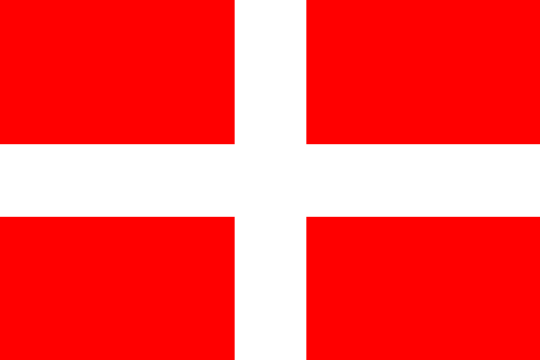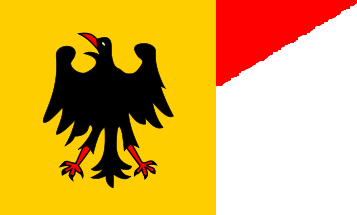 Image by Jaume Ollé
Image by Jaume Ollé
Last modified: 2012-11-12 by pete loeser
Keywords: holy roman empire |
Links: FOTW homepage |
search |
disclaimer and copyright |
write us |
mirrors
Note: The colours red and white were very significant in the Holy Roman Empire. When the Holy Roman Empire took part in the Crusades, a red and white war flag was flown alongside the black-gold Imperial banner. This flag had a white cross on a red background: the reverse of the St. George's Cross used as the flag of England.
The Imperial Army of the Holy Roman Empire (Reichsarmee) was first created in 1422. The army was not a permanent standing army, but was mustered when there was some danger. Because of this, many of the imperial troops had stronger local ties than any loyalty to the Emperor.
The size of the Army was controlled by the Imperial Army Constitution (Reichsdefensionalordnung) of 1681 which determined the composition of the army, and fixed the levy of how many troops had to be provided by the various "Imperial Circles" of the Empire.
The Imperial Register (Reichsmatrikel or Heeresmatrikel) determined levy of the individual states. The total strength was eventually set at 40,000 men, consisting of 28,000 infantry and 12,000 cavalry, including 2,000 dragoons (mounted infantry). In emergencies, however, the size of the army could be increased by doubling or tripling the contingents.
Text edited from Wikipedia

Speculative image by Pete Loeser, 24 July 2011
Like the Imperial Banner the War flag had a black (one-headed) eagle on a gold field, with a red Schwenkel attached.
Norman Martin, 14 January 1998
Two additional flags associated with the Empire worth mentioning are the Sankt Georg Fahne - a white St. George's cross on a red field frequently with a Schwenkel - (Smith 1975, p.115, labels this the Imperial War Flag) and the Reichsturmfahne.
Norman Martin, 14 Jan 1998
Even though I found no reference to the Sankt Georg Flagge as war flag except in Smith 1975, it is clear that its primary use was military and in view of Smith's identification, I would not be surprised if it were sometimes or even frequently called Reichskriegsflagge.
Norman Martin, 15 Mar 2000
![[Unterpfälzisches Regiment zu Fuß Waldmannshausen (1620) (Holy Roman Empire, Germany)]](../images/d/de^wmh6.gif) Image by Klaus-Michael Schneider, 24 Jun 2009
Image by Klaus-Michael Schneider, 24 Jun 2009
Unterpfälzisches Regiment zu Fuß Waldmannshausen (1620) - 6th Company: yellow with red bend.
Source: Fahnen und Flaggen. Eine bunte Fibel by Ottfried Neubecker, 1939 [neu39a], p.26-27
![[Unterpfälzisches Regiment zu Fuß Waldmannshausen (1620) (Holy Roman Empire, Germany)]](../images/d/de^wmh7.gif) Image by Klaus-Michael Schneider, 24 Jun 2009
Image by Klaus-Michael Schneider, 24 Jun 2009
Unterpfälzisches Regiment zu Fuß Waldmannshausen (1620),
7th Company: blue with red bend.
Klaus-Michael Schneider, 24 Jun 2009
![[Unterpfälzisches Regiment zu Fuß Waldmannshausen (1620) (Holy Roman Empire, Germany)]](../images/d/de^wmh8.gif) Image by Klaus-Michael Schneider, 24 Jun 2009
Image by Klaus-Michael Schneider, 24 Jun 2009
Unterpfälzisches Regiment zu Fuß Waldmannshausen (1620),
8th Company: yellow with blue bend.
Klaus-Michael Schneider, 24 Jun 2009
![[Unterpfälzisches Regiment zu Fuß Waldmannshausen (1620) (Holy Roman Empire, Germany)]](../images/d/de^wmh9.gif) Image by Klaus-Michael Schneider, 24 Jun 2009
Image by Klaus-Michael Schneider, 24 Jun 2009
Unterpfälzisches Regiment zu Fuß Waldmannshausen (1620),
9th Company: blue with yellow bend
Klaus-Michael Schneider, 24 Jun 2009
![[Unterpfälzisches Regiment zu Fuß Waldmannshausen (1620) (Holy Roman Empire, Germany)]](../images/d/de^wmh10.gif) Image by Klaus-Michael Schneider, 24 Jun 2009
Image by Klaus-Michael Schneider, 24 Jun 2009
Unterpfälzisches Regiment zu Fuß Waldmannshausen (1620), 10th Company: blue with white bend.
Klaus-Michael Schneider, 24 Jun 2009
There are several places called Moncontour in France. The Battle of Moncontour took place near the village of Moncontour (1,008 inhabitants in 2006), located in the department of Vienne, historical province of Poitou. The battle was of short duration, but particularly bloody: the Huguenots lost 6,000 men (nearly one third of their troops), while the Catholics lost "only" 600 men. Henri III then bore the title of the Duke of Anjou.
![[Ducal regiment flag (1569) (Holy Roman Empire, Germany)]](../images/d/de^pzb.gif)
Image by Klaus-Michael Schneider, 24 Jun 2009
Ducal regiment flag: The ratio was approx 11:19 plus an embowed end added to the fly. The hoist consists of diamonds of the colours blue, red, yellow and white. The fly consists of nine horitontal stripes in order: yellow-blue-red-yellow-red-blue-white-yellow-red. One single red diamond is superimposed by a small white cross like that one of Schwyz canton, but in this case it is the ensign of the alliance of Huguenots.
Source: [neu32], p.31, image
no.98
Klaus-Michael Schneider, 24 Jun 2009
![[Ducal cavalry flag (1569) (Holy Roman Empire, Germany)]](../images/d/de^pcav.gif)
Image by Klaus-Michael Schneider, 24 Jun 2009
Ducal cavalry flag: It is a triangular pennant, mainly white but with blue, black and yellow pieces of cloth. The white cross of the alliance of Huguenots is placed into the upper blue piece of cloth.
Source: [neu32], p.31, image
no.99
Klaus-Michael Schneider, 24 Jun 2009
![[Regiment Hohengeroldseck flag (1569) (Holy Roman Empire, Germany)]](../images/d/de^hge.gif)
Image by Klaus-Michael Schneider, 24 Jun 2009
Regiment Hohengeroldseck: The ratio was approx 11:19 plus an embowed end added to the fly. The hoist was yellow, flamed five times horizontally red. The fly was red with the white cross of the alliance of Huguenots in its centre. The regiment was lead by count Quirin Gangolf of Hohengeroldseck, which was a small territory in the Black Forrest. The count was colonel of 15 companies and in service of Wolfgang of Palatinate-Zweibrücken. The flags of all companies were red and yellow with the white cross. The patterns of the companies were different.
Sources: [neu32], p.31 , image
no.100; [neu39a], p.27
Klaus-Michael Schneider, 24 Jun 2009
![[Regiment Granweiler flag (1569) (Holy Roman Empire, Germany)]](../images/d/de^gwe.gif)
Image by Klaus-Michael Schneider, 24 Jun 2009
Regiment Granweiler: The ratio was approx 11:19 plus an embowed end added to the fly. It was a 7-stripes flag, divided horizontally with ratio 1:1:1:3:1:1:1. The central stripe was red with with the white cross of the alliance of Huguenots in its centre. The others were from top to bottom: red-yellow-mixed - mixed-blue-white. The mixed stripes were divided horizontally twice into:blue-red-yellow-white(upper) and white-yellow-red-blue(lower). I found no information about Granweiler.
Sources: [neu39a], p.27
Klaus-Michael Schneider, 24 Jun 2009